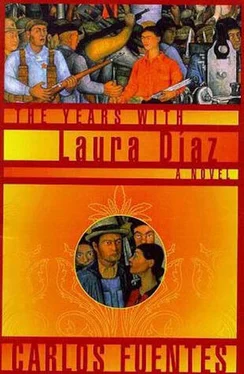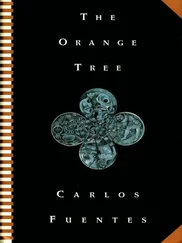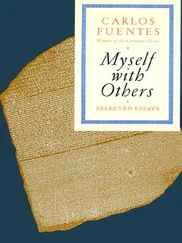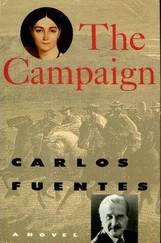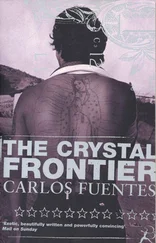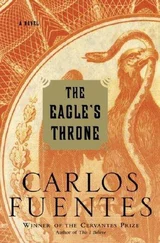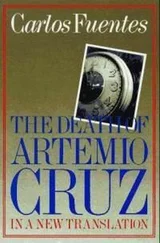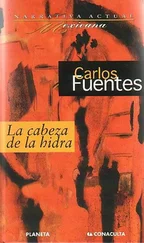A man with a burning torch ran screaming through the halls of the abandoned house, setting fire to everything that would burn. I was hit on the back of my neck and fell, staring up at an upside-down, solitary skyscraper under a drunken sky. I touched the burning blood of a summer that still hadn’t come, I drank the tears that won’t wash away the darkness of someone’s skin, I listened to the noise of the morning but not its desired silence, I saw children playing among the ruins, I examined the prostrate city, offering itself for examination without modesty. My entire body was oppressed by a disaster of brick and smoke, the urban holocaust, the promise of uninhabitable cities, no man’s home in no man’s city.
I managed to ask myself as I fell if it were possible to live the life of a dead woman exactly as she lived it, to discover the secret of her memory, to remember what she would remember.
I saw her, I will remember her.
It’s Laura Díaz.
SOMETIMES IT’S POSSIBLE to touch memory. The family legend retold most often concerned the courage of Grandmother Cosima Kelsen when, back in the late 1860s, she journeyed to Mexico City in order to buy furniture and accessories for her house in Veracruz and, on her way back, her stagecoach was stopped by bandits who still wore the picturesque costume derived from the uniforms of nineteenth-century civil wars — wide-brimmed, round hat, short suede jacket, bell-bottom trousers, the ensemble held together by buttons of old silver, short boots, and jingling spurs.
Cosima Kelsen preferred evoking those details to recounting what happened. After all, the anecdote was better — and therefore more incredible, more extraordinary, more long-lasting, and known to more people — when many voices repeated it, when it passed (acknowledging the redundancy) from hand to hand, since the tale concerned hands. Fingers, actually.
The stagecoach was stopped at that strange spot on the Cofre de Perote where instead of ascending through the mist, the traveler descends from the diaphanous height of the mountain into a lake of fog. The gang of bandits, called chinacos, camouflaged by the mist, materialized with the noise of neighing horses and pistol shots. “Your money or your life” is the usual refrain of thieves, but these, more original, demanded “your life or your life,” as if they understood all too well the haughty nobility, the rigid dignity the young Doña Cosima displayed as soon as they appeared.
She didn’t deign to look at them.
Their leader, formerly a captain in Emperor Maximilian’s defeated army, had loitered around the Chapultepec court long enough to be able to recognize social differences. He was famous in the Veracruz region for his sexual appetites — his nickname was the Hunk of Papantla — and equally famous for knowing the difference between a lady and a tart. Even though he’d been reduced to banditry after the imperial defeat, which culminated in the execution in 1867 of Maximilian along with the generals Miramón and Mejía — The three M’s, mierda, the superstitious Mexican condottieri would exclaim — the respect this former cavalry officer showed toward ladies of rank was instinctive, and, after first seeing Doña Cosima’s eyes as brilliant as copper sulphate and then her right hand clearly resting on the sill of the carriage window, he knew exactly what he should say to her:
“Please, madam, give me your rings.”
The hand that Cosima had so provocatively exposed boasted a gold wedding band, a dazzling sapphire, and a pearl ring.
“These are my engagement and wedding rings. You’d have to cut them off me.”
Which is exactly what the fearsome former imperial officer did without missing a beat, as if both knew the protocol of honor: one stroke of his machete and he cut off the four exposed fingers of young Grandmother Cosima Kelsen’s right hand. She didn’t even wince. The savage officer took off the red scarf he was wearing on his head in the old chinaco- bandit style and offered it to Cosima to bandage her hand. He dropped the four fingers into his hat and stood there like a haughty beggar, with the fingers of the beautiful German woman taking the place of alms. When he put his hat back on, blood ran down his face. For him, that red bath seemed as natural as diving into a lake would be for other people.
“Thank you,” said the beautiful young Cosima, looking at him for the first and only time. “Will you be requiring anything else?”
The Hunk of Papantla’s only answer was to lash the rump of the nearest horse, and the coach spun away down the slope toward the hot land of Veracruz, its destination beyond the mountain mists.
“No one is to touch that lady ever again,” said the chief to his crew, who all understood that disobedience would cost them their lives and that their leader, for an instant and perhaps forever, had fallen in love.
“But if he fell in love with Grandmama, why didn’t he give her back the rings?” asked Laura Díaz when she was old enough to think things through.
“Because he had no other souvenir of her,” answered Aunt Hilda, the eldest of Cosima Kelsen’s three daughters.
“But what did he do with the fingers?”
“That’s something we don’t talk about, child,” answered the second of the trio, the young Fräulein Virginia, energetic and irritated, dropping the book she happened to be reading of the twenty she read each month.
“Watch out for die gypsie’,” said the hacienda cook in her greedy coastal accent that devoured s ’s. “Dey cut’ off die finger’ for to make tamale’.”
Laura Díaz stared down at her hands — little hands — and held them out and childishly twirled her fingers as if she were playing a piano. Then quickly she hid them under her blue-checkered school apron and observed with growing terror the activity of fingers in her father’s house, as if all of them, at all hours of the day and night, did nothing but exercise what the Hunk of Papantla had taken away from the then young and beautiful and recently arrived Miss Cosima. Aunt Hilda, with a kind of hidden fever, played the Steinway piano brought from the port of Veracruz from New Orleans, a long voyage that seemed short because, as the passengers noted and then told Fräulein Kelsen, seagulls accompanied the ship, or perhaps the piano, from Louisiana to Veracruz.
“Mutti would have been better off going to la Nouvelle-Orléans to buy her trousseau and enjoy her nozze, ” bragged and criticized Aunt Virginia in one breath. Mixing languages was as natural for her as mixing her reading matter, and it challenged, in an irreproachable way, one of her father’s goals. New Orleans, in any case, was the civilized commercial point of reference closest to Veracruz, and the place where, exiled by the dictatorship of the peg-legged Santa Anna, the young liberal Benito Juárez had once worked rolling Cuban cigars. Would there be a commemorative plaque in New Orleans after Juárez — so ugly, such a little Indian — defeated the French and ordered the very Habsburg Maximilian — so blond, so handsome — shot?
“The Habsburgs governed Mexico longer than anyone, don’t you forget it. Mexico is more Austrian than anything else,” said the well-read and well-written Virginia to her youngest sister, Leticia, Laura Díaz’s mother. For Leticia, this news of the empire was simply inconsequential since the only things that mattered to her were her home, her daughter, her kitchen, her diligent attention to daily life …
At the same time, the melancholy resonance that Hilda’s agile fingers gave to Chopin’s Preludes, her favorite music, augmented every particle of sadness — real, remembered, or imaginable — in the vast but simple house on the hill above the tropical lake.
Читать дальше
